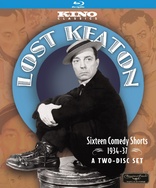Lost Keaton Blu-ray Movie
HomeLost Keaton Blu-ray Movie 
Kino Lorber | 1934-1937 | 306 min | Not rated | Mar 20, 2012Movie rating
6.9 | / 10 |
Blu-ray rating
| Users | 0.0 | |
| Reviewer | 3.0 | |
| Overall | 3.0 |
Overview
Lost Keaton (1934-1937)
The films Buster Keaton made with Educational Pictures (ALL sixteen of which are collected here) pay homage to his earlier work, but at the same time incorporated the element of sound, all while exploring new possibilities for his recurring comic persona, Elmer.
Starring: Buster Keaton, Myra Keaton, Lona Andre, Dorothea Kent, Tiny Sandford| Comedy | 100% |
| Adventure | Insignificant |
Specifications
Video
Video codec: MPEG-4 AVC
Video resolution: 1080p
Aspect ratio: 1.34:1
Original aspect ratio: 1.37:1
Audio
English: LPCM Mono
Subtitles
None
Discs
50GB Blu-ray Disc
Two-disc set (2 BDs)
Packaging
Slipcover in original pressing
Playback
Region free
Review
Rating summary
| Movie | 3.0 | |
| Video | 3.5 | |
| Audio | 3.0 | |
| Extras | 0.5 | |
| Overall | 3.0 |
Lost Keaton Blu-ray Movie Review
Even Keaton had to pay the bills.
Reviewed by Casey Broadwater March 19, 2012The title of this collection, Lost Keaton, is perfectly apt. Not only are the sixteen two-reel shorts included here forgotten rarities from Keaton's
body of work--some forgotten for good reason--they were also made at a time when Buster himself was lost, an erstwhile silent star whose
transition
to "talkies" was stunted by studio interventions and personal problems. In 1928, after nearly a decade of complete creative control--during which he
produced classics like Steamboat Bill Jr.
and The General
--Keaton signed a contract with MGM. It would be the most regretted decision
of his life. MGM nixed his script ideas, forced him to use stunt doubles, and later paired him with singer/comedian Jimmy Durante for a series of films
that were popular at the time but haven't aged well. Driven to drink by a messy divorce, Keaton became more of a blackout-prone liability than a
comedic asset, and MGM cut him loose.
None of the other big studios would take him. After a brief retreat from Hollywood, Buster signed on with Educational Pictures, a so-called "Poverty
Row" B-movie studio that initially made instructional films for schools before becoming a factory for low-budget comedies. Considering the overall
blandness of their output, the studio's motto--"The Spice of the Program"--seems in retrospect like a self-deprecating joke. Each of the sixteen films
Keaton made for Educational Pictures had a measly $20,000 budget, $5,000 of which went to Keaton. It's always sad to see a favorite actor slumming
for a paycheck, and that's the feeling you get watching the majority of these mostly unfunny shorts--you feel bad for Buster. His deadpan
humor and simultaneously out-of-control and in-control physicality--the elements of his particular comedic genius--go largely wasted here. Although
there are
a few lost gems in this collection, like Hayseed Romance and Grand Slam Opera, there are none that compare to the unbridled
brilliance of his earlier silent films.
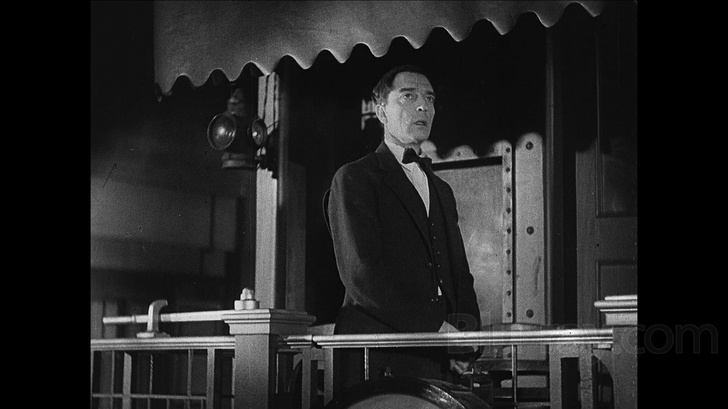
Keaton, lost...
The Gold Ghost (1934, 20:55): Buster's first short with Educational Pictures finds him as a spurned city boy who heads out west to get away from womankind. His cars runs out of gas in Vulture City, a ghost town, where Keaton pratfalls through the dusty streets before rather glumly pinning a tin star to his chest and proclaiming himself sheriff. Loneliness gets the best of him for a while--he hallucinates some Old West-era double-exposure ghosts in the short's most memorable sequence--but when gold rush fever strikes again, flooding the town with prospectors, he's forced to lay down the law with comic ineptness.
Allez Oop (1934, 20:33): In Allez Oop, Buster puts the fall in "falling in love." As Elmer, a watch repairman at "Ye Oldee Clockee Shoppee," he pines for repeat customer Paula (Dorothy Sebastian) and spends most of reel one trying to figure out how to ask her on a date to the circus. When they finally make it to the Big Top, Elmer spills popcorn and soda everywhere and Paula develops a crush on star acrobat The Great Apollo. To compete, Elmer builds a makeshift trapeze in his backyard and Buster gets to show off some of his old comic agility, flailing around hilariously and getting caught in the ropes.
Palooka from Paducah (1935, 20:05): Keaton played some country rubes in his time, but here he's a full-on hillbilly, complete with a ridiculous Abe Lincoln-style beard and parody accent. When the end of Prohibition puts an end to his folk's moonshine business, Buster trains his older brother as a professional "wrassler," hoping they can go down to Paducah and "make a heap of money." This one is a real vaudeville family affair, starring Buster's father Joe, his mother Myra, and sister Louise as members of the redneck clan. Of course, Buster himself ends up in the ring--and thrown out of the ring, and back into the ring--when he referees the big match. There are a few funny bits here--like Buster getting his head stuck in a hay bale--but Palooka just isn't as good as its premise suggests.
One Run Elmer (1935, 19:08): Keaton's new "Elmer" character makes his second appearance as the owner of a gas station way out in the middle of the southwestern desert. When a competitor, Jim (Harold Goodwin), sets up shop across the road, the two ending up vying not only for customers, but also for the heart of a baseball-loving girl (Lona Andre) who drives into their lives and agrees to date whoever is the best player. Keaton was a noted baseball fan--he was even known to arrange pick-up games on set--and here he makes an absurdity of the game, coming to the plate with an enormous bat, sliding into first--spraying limestone all over the first baseman--and even hitting a bullet-assisted home run.
Hayseed Romance (1935, 20:08): One of the better shorts in the collection, Hayseed Romance harkens back to the witty slapstick that characterized Keaton's early career. Buster--once again, as Elmer--answers a want-ad looking for a farmhand and potential husband, and when he turns up at the house, he's excited to be greeted by Molly (Dorothea Kent), a pretty young blond. Disappointment sets in, however, when he meets the girl's seriously hefty aunt (Jane Jones), who actually placed the ad, and who promptly begins thumping Buster on the back and checking his teeth-- as if he were a horse--before sending him to work in the kitchen. Later, the obese aunt causes a veritable earthquake when she bellows out a tune at the organ--Buster literally flies out of his chair--but the the real laughs come in reel two, when Buster has to contend with a leaky roof, an extremely bouncy bed, and an enormous mud puddle. Stick around for the shotgun wedding ending.
Tars and Stripes (1935, 19:52): If Hayseed Romance is one of the best, Tars and Stripes is in the running for the worst. It's almost cringe-worthily painful to watch Keaton run through this series of lame gags as Apprentice Seaman Elmer Doolittle, an inept naval trainee who can't do right by his commanding officer (Vernon Dent). The short was filmed on location at the U.S. Naval Training Base in San Diego, which gives at least some color to the proceedings, but otherwise Tars and Stripes is awful--repetitive, dull, and woefully unfunny. Just about every joke falls flat thanks to poor timing and lousy editing. There are precious few Keaton films I could do without, and this is definitely one of them.
The E-Flat Man (1935, 20:02): Another clunker. Elmer and his girlfriend (Dorothea Kent) are about to elope when a pair of gangsters steal Elmer's automobile. Somehow, Elmer mistakes a cop car for his own and inadvertently steals it, making him and his runaway bride accidental criminals, on the lam from the law. But their hijinks just aren't very entertaining. When the funniest thing in the film is a cow that sticks out its tongue, you know something's wrong. This one also features what may be the most boring roll in the hay in all of cinema history.
The Timid Young Man (1935, 19:55): Directed by Mack Sennett--the former "King of Comedy" responsible for the slapstick genius of The Keystone Kops--The Timid Young Man is the case of two men way past their primes. Keaton and Sennett had both seen better days, and it's a shame their only collaboration together would happen this late in their respective careers. The results are as disappointingly mediocre as you'd expect. Still, there are at least a few good moments here, and The Timid Young Man stands out as being one of the more dialogue- driven shorts Keaton did with Educational Pictures. Buster plays Milton, a misogynist who drives away from his fiancee only to pick up a female hitchhiker (Lona Andre) for some rustic adventures. There's a cute dog that swallows Mexican jumping beans and a run-in with a salad-loving hulk (Tiny Sandford) who wants the girl for his own, but the plot doesn't make much sense and doesn't really go anywhere.
Three on a Limb (1936, 18:10): This is a weird one. Keaton rolls into a drive-in diner wearing a sort of grown-up Boy Scouts uniform, for no other reason than that it looks funny. (And it does.) As in so many of these shorts, he falls in love at first sight, this time with the waitress (Lona Andre), whom he drives home. Eventually, we learn there are two other men vying for her affections, and this leads to a madcap wedding ceremony that involves a lot of pushing and shoving. Keaton does a decent bit with a fire hose--after starting a fire in the girl's parents' apartment--but otherwise Three on a Limb isn't very memorable.
Grand Slam Opera (1936, 20:30): Wonder of wonders, Grand Slam Opera starts with Keaton singing--yes, singing--belting out a spoof of a song from Yankee Doodle Dandy as he boards a train bound for New York. This time around, "Elmer" is a juggler, and he's come to the Big Apple to find fame. He goes about it all wrong, weaseling his way onto a radio program to perform during amateur hour, and of course the joke here is that listeners at home can't see his tricks. (Perhaps an inadvertent metaphor for Keaton's inability to succeed in the sound era?) Amongst Keaton fans, Grand Slam Opera is a favorite from this particularly low period of his life, and for good reason--Buster gets to bust out some old vaudeville stand-bys, including a balancing act with a pool cue and bowling ball, and pratfalls galore. The highlight of the short, though, is the rapidly shifting dance Keaton performs at the radio orchestra's rehearsal, which has him comically imitating Spanish, Irish, Russian, and Egyptian jigs.
Blue Blazes (1936, 18:56): In Blue Blazes, Buster's Elmer is a misfit fireman in the city who blunders so often that he gets sent out to the suburbs to a station that never gets any action. (The rather effeminate firefighters here can be seen sewing up dolls for little girls and tending to the station's plants.) Naturally, as soon as Elmer shows up a five-alarm fire breaks out, but Buster falls off the truck--a pretty spectacular stunt--and spends most of the rest of the short trying to find the fire. The ultra-low budget is apparent in some really bad continuity errors toward the end--the timeframe switches incongruously between night and day--but Blue Blazes is at least watchable, if never outright entertaining.
The Chemist (1936, 18:59): Here's a great set-up, and one that almost lives up to the comic promise of its premise. Keaton's Elmer is a cut-rate chemistry professor at "Duncemore College," and the short opens with him making eggs, toast, and coffee with help from his laboratory equipment. (The scene might remind you of Breaking Bad.) The piece starts slow with a bit that has Elmer trying to woo a girl with a piece of love-potion infused chocolate, but the pace picks up when he invents a noiseless, water-activated explosive that draws the attention of a trio of bank robbers, who want the powder for their next vault bust. From here, the action is non-stop, and Elmer cleverly turns the table on the robbers using nothing more than a bottle of seltzer water and the promise of rain.
Mixed Magic (1936, 16:28): Elmer as a magician's assistant? What could go wrong? The answer, of course, is everything, and Mixed Magic turns out to be one of the better two-reelers Keaton made for Educational Pictures. After lucking his way into a gig with carnival magician Professor Spumoni (Eddie Lambert), Elmer brings down the house with one botched magic trick after another, fainting onstage, releasing several ducks at the wrong part of the act, and causing a levitation gag to go haywire.
Jail Bait (1937, 18:58): Despite the title, don't expect Keaton to get in trouble here with any underage girls. No, in this case, Keaton himself is the jail bait, pretending to a be a murderer so that he can distract the cops while his reporter roommate gets the scoop on the real killer. It's a harebrained scheme, and not surprisingly it all goes wrong, with Elmer getting arrested, sentenced to death, and inadvertently assisting in a jailbreak. This one's watchable, but hardly hilarious.
Ditto (1937, 17:03): One of the stranger entries in Keaton's Educational Pictures oeuvre. Keaton plays an ice delivery man who falls for one of his customers after "buttering her arm." (Trust me, it sounds kinkier than it actually is.) What he doesn't know is that the woman has a twin sister in the adjoining duplex, and that both of them are married. Expect lots of miscommunications and switcheroos, none of which are particularly funny. The short takes a turn for the weird when the heartbroken Keaton runs away to Canada and becomes a bearded, coonskin hat-wearing hermit. The film jumps fifteen years forward--we know it's the future because airliners are towing Winnebagos (!)--and Buster has another encounter with a set of identical siblings.
Love Nest on Wheels (1937, 17:56): Keaton's final film for Educational Pictures is a loose reworking of Fatty Arbuckle's The Bell Boy, a short Keaton costarred in back in 1918. Here, Buster's Elmer is the oldest son in a hillbilly clan that owns a dilapidated hotel about to be seized by the bank. (To give an idea of how rinky-dink the place is, its elevator is donkey-powered.) To raise the funds needed to avoid foreclosure, Elmer tries to sell a towable trailer to a honeymooning couple, but first he has to get a stubborn cow out of it. There some decent gags here--including a near- decapitation that's actually quite harrowing--but nothing on par with Keaton's best work. Like Palooka from Paducah, Love Nest on Wheels features several members of Keaton's family, including his mother Myra, sister Louise, and brother Harry.
Lost Keaton Blu-ray Movie, Video Quality 
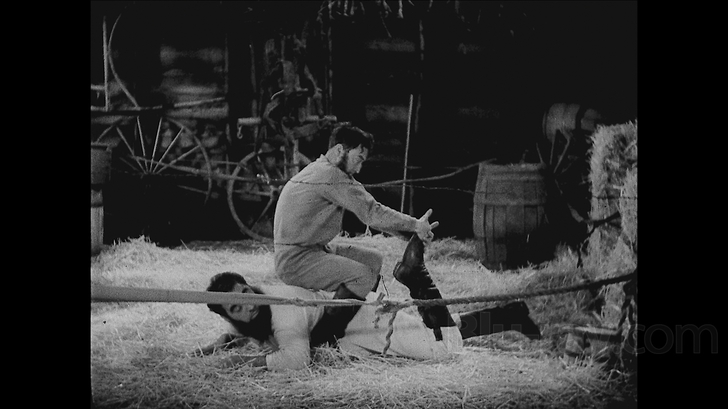
On the back of the Blu-ray case, it states, "These discs were remastered in HD from 35mm negatives and fine grain masters from Keaton's personal collection and other archival sources by Raymond Rahauer." So, yes, you're getting the best possible prints available of these shorts. But that sentence is followed by this: "Some films exist in less-than-perfect condition, which is not atypical for low-budget 'orphan' films such as these." In truth, none of the films here are in "perfect" condition. Some of the shorts are understandably more damaged than others, some are cobbled together from multiple sources, but you can expect all of the prints to feature specks, light debris, vertical scratches, and mild brightness flickering. Like most Kino releases, there's been no attempt to digitally clean up any of this, and since I doubt many would deem it worth the time and money to do an exhaustive visual overhaul of these lesser-Keaton shorts, I'm fine with this hands-off approach. The lack of digital intervention also means you don't have to worry about texture-erasing DNR or halo-inducing edge enhancement. The films are essentially presented "as is." And, despite the almost ever-present print damage, they don't look bad. In general, there's a decent sense of clarity in the picture--though the image is hardly sharp sharp--and the black and white balance is good, with highlights that are rarely overblown and shadows that rarely crush. I didn't spot any encode quirks or compression problems either.
Lost Keaton Blu-ray Movie, Audio Quality 
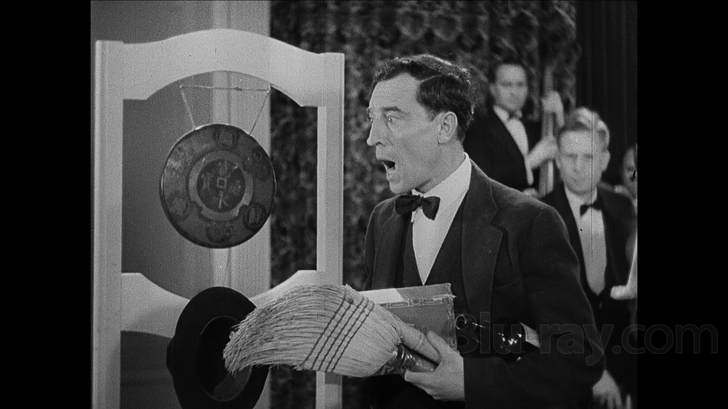
The audio on these shorts fares a bit worse than the picture quality, simply because audio degradation is harder to ignore than print damage. You'll hear crackles and pops galore--a bowl of Rice Crispies isn't a bad comparison, actually--and many of the shorts include a low but persistent tape hiss. Dialogue is always at least understandable, but there are definitely times when voices sound muffled or overdriven. The same goes for the musical accompaniment, which has a tendency to sound a bit brash, with an upper range that peaks and cracks. (Just listen to the fiddles at the beginning of Love Nest on Wheels.) Still, Kino has done what it can, giving each film an uncompressed LPCM 2.0 mono track. And honestly, I don't think these shorts will, or even can sound better. My sole complaint is that Kino has once again neglected to include subtitle options for those who might need or want them.
Lost Keaton Blu-ray Movie, Special Features and Extras 
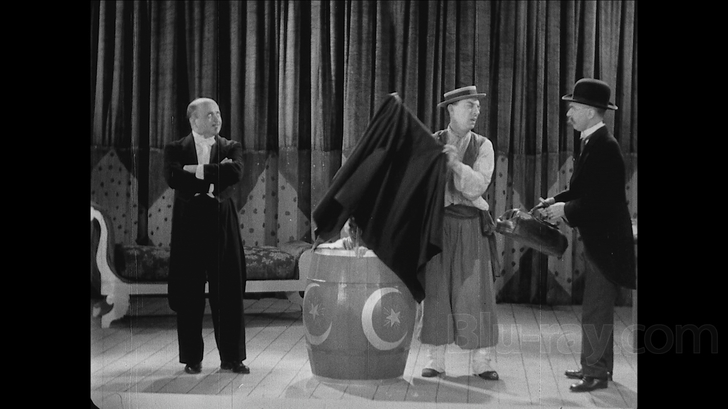
On disc one there's a gallery with sixteen stills, and on disc two you'll find Why They Call Him Buster (1080p, 1:12), a montage of pratfalls, but these are the only on-disc extras. Inside the Blu-ray case, though, there's a helpful booklet with overviews of each film by David Macleod, author of The Sound of Buster Keaton.
Lost Keaton Blu-ray Movie, Overall Score and Recommendation 
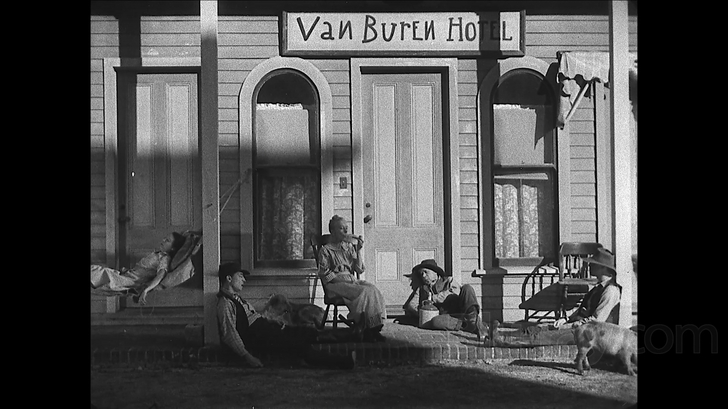
If you're just starting to explore the brilliant career of Buster Keaton, this collection most definitely isn't the place to start, and you'd be better off beginning with The Short Films Collection and working your way forward chronologically. In fact, I'd say Lost Keaton will only appeal to real Keaton completists, diehards who want to own everything the comedic maestro ever set to film, even the sub-par work he did as a hired gagster for Educational Pictures. These shorts are preserved as faithfully as possible on Blu-ray, but I can't say they're essential viewing. Recommended for hardcore Keaton connoisseurs only.
Similar titles
Similar titles you might also like

The Saphead
Ultimate Edition
1920

Buster Keaton: The Short Films Collection
One Week / Convict 13 / Neighbors / The Scarecrow / The Haunted House / Hard Luck / The High Sign / The Goat / The Play House [Playhouse] / The Boat / The Paleface / Cops / My Wife's Relations / The Frozen North / The Electric House / Day Dreams [Daydreams] / The Balloonatic / The Love Nest
1920-1923

College
1927

Our Hospitality
Remastered
1923

The Navigator
1924

Seven Chances
1925

Steamboat Bill, Jr.
1928

The General
1926

Spite Marriage
1929

Three Ages
1923

The Cocoanuts
1929

The Fireman
1916

Champagne
1928

Every Day's a Holiday
1937

The Count
1916

Speedy
1928

Behind the Screen
1916

The Rink
1916

The Cure
1917

One A.M.
1916
